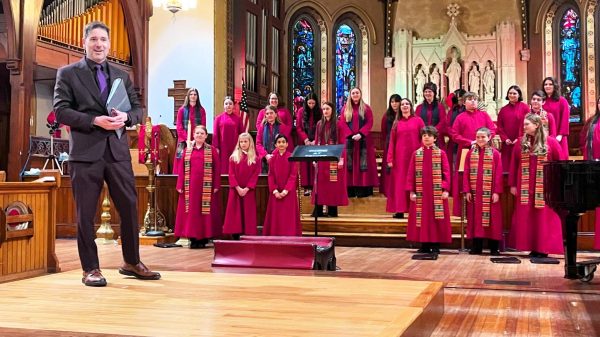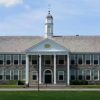KENT—A little blue-headed kestrel was a recent guest of honor when the Kent Greenhouse celebrated the fall season with a day filled with fun activities for adults and children alike.

Garden Center specialist Melony Forstmann said Kent Greenhouse wanted to celebrate fall and Halloween by planning a variety of activities for families, including a program on raptors. ‘
We wanted to teach the kids about wildlife and to encourage them to be aware [of environmental concerns,]” she said.
Bethany Sheffer, volunteer coordinator and naturalist with the Sharon Audubon Society, brought the little bird to the celebration and talked about him for an attentive audience.
She said the kestrel is a cavity nester and faces fierce competition for tree cavities from other creatures who also prefer them for their homes.
Like many species, birds of prey are suffering from habitat loss and the kestrel, which is a small falcon about the size of a robin, was listed as “threatened” on Connecticut’s Endangered, Threatened, and Special Concern Species List in 2004. It was later listed as a species of special concern in 2015.
Kestrels can be seen in Connecticut throughout the year but are less uncommon in winter. They are more frequently seen as migrants in fall and spring.
Migrant populations increased during the early 1900s, but resident breeding populations were comparatively low.
Kestrels were more numerous when agriculture was at its peak in Connecticut. Currently, with the disappearance of agriculture, along with the regrowth of forests and an increase in suburban development, open, grassy areas are in short supply.
This change in Connecticut’s landscape has caused many wildlife species that rely on open areas, including the kestrel, to experience long-term declines.
One to 2 billion birds are killed by building collisions in the United States each year.
—Lights Out Connecticut
Sheffer urged her listeners to go to the website Audubon.org/IBirdIVote and pledge to vote for candidates who support environmental practices that protect bird habitats.
The non-partisan plea encourages voters to look at state and local elections that will affect the future of communities, habitats and the creatures that call them home.
With nearly 2 million members nationwide and 30,000 members in just Connecticut, Audubon is an influential voice in public policy decisions. Sheffer said it supports the rapid expansion of renewable energy resources such as solar panels and helps identify locations for them that are the least harmful to wildlife and communities.
Audubon also supports increasing research and funding for natural climate solutions. Members believe that natural climate solutions and renewable energy are important to mitigating climate change and that addressing biodiversity loss is a necessary part of stabilizing the climate.
Audubon’s climate strategy includes generating and transmitting 100 gigawatts of renewable energy and storing 30 billion tons of carbon through natural systems such as sequestering it in trees.
Locally, many communities are exploring the Dark Skies movement, which seeks the reduction of light pollution through mindful construction and lighting techniques—the Kent Library expansion, for instance, will feature downward directed light to reduce pollution.

Lights Out Connecticut is another voluntary effort aimed at reducing excessive exterior and interior lighting during peak periods of bird migration. Millions of migratory birds pass through Connecticut every spring and fall.
Science reveals that many species of songbirds evolved to migrate at nighttime, when the skies are safer. The migratory birds navigate by cues in the night sky, including the light of the moon and stars, and light pollution from buildings, street lights, bridges, and other structures can confuse and disorient migratory birds, causing them to veer off path and become exhausted or to crash into buildings.
One to 2 billion birds are killed by building collisions in the United States each year. Lights Out Connecticut urges residents and businesses to turn off excessive lighting from 11 p.m. to 6 a.m. when birds are migrating.
The peak fall migration is currently underway and will continue until mid-November.




























